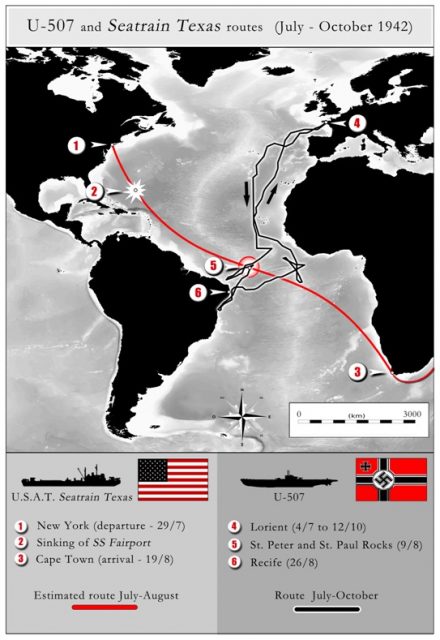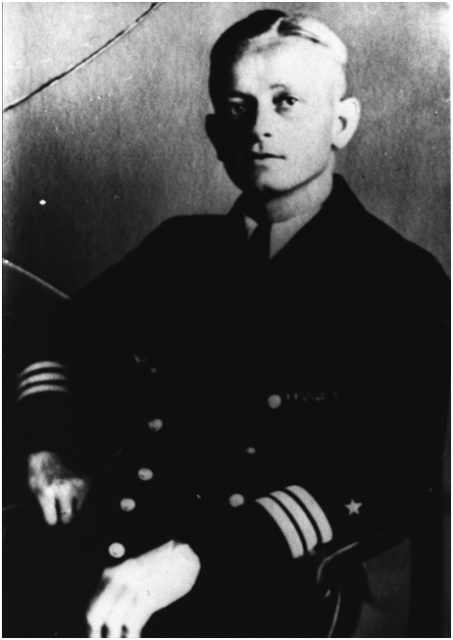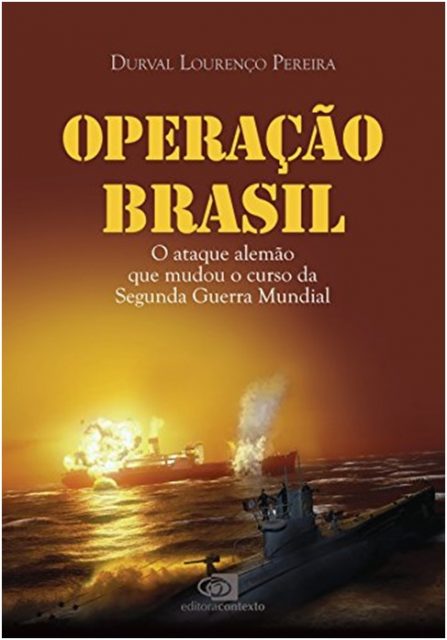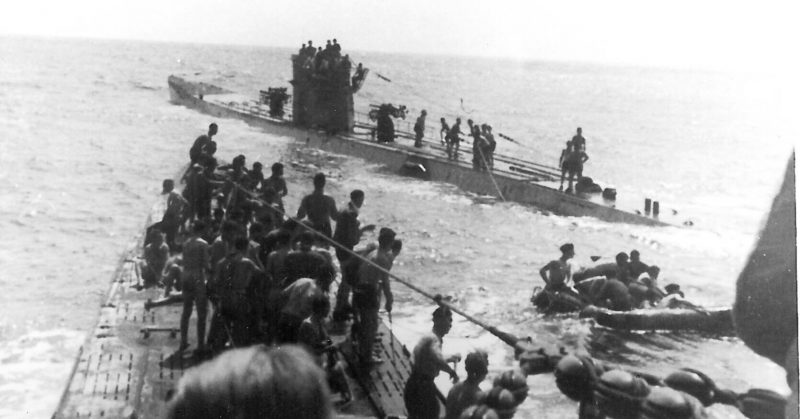War History Online presents this Guest Article from Durval Lourenço Pereira
This article offers a reevaluation of the Allied victory at the Second Battle of El Alamein (November 11, 1942): the turning point of World War II. The battle was thoroughly studied for decades until it was considered by many as a historically depleted event. Nevertheless, on its 75th anniversary, an original research on American, Brazilian and German files revealed a new and surprising fact. This article offers concrete evidence that the Allies’ victory at El Alamein and the Battle of the Atlantic had an almost unknown main character.
On the morning of June 21st, 1942, the two most powerful men of the West were gathered in the Oval Office at the White House, in Washington. President Franklin D. Roosevelt and Prime Minister Winston Churchill discussed the Allies’ war strategy against the Axis. During the meeting, a telegram reached Roosevelt’s hands. The President read the message and, without saying a single word, passed it on to Churchill, who was standing beside him. When its contents had sunk in, the Englishman took a half step back as to better balance himself, and his famous pink cheeks abruptly lost their color. The contents of the telegram were devastating: “Tobruk has surrendered. 25,000 men were made prisoners.” The English fortress in the North of Africa had fallen into German hands. The fall of Tobruk to the Afrika Korps struck a heavy blow to the English Prime Minister’s pride, who would later earnestly describe the critical moment in his Memoirs: “It was the strongest blow that I recall from all the war, not only because of its dire effects on the Army, but for the reputation of British armies”.
What can we do to help?
Roosevelt asked his unnerved English colleague, “What can we do to help?” Still in shock from the terrible news, Churchill answered immediately, without flinching or turning to any of his military advisors, “Give us as many Shermans tanks as you can spare, and ship them to the Middle East as quickly as possible.” Thusly, on July 13th, 1942, the AS-4 convoy, shipping 317 M4 “Sherman” tanks, 100 M7 “Priest” self-propelled Artillery Gun, 13,000 tons of munition and several materials set sail from New York.
With navigation through the Mediterranean Sea closed off to the Allies, the only maritime route to supply the Commonwealth troops of Egypt had to go around the African continent. The path imposed a long and risky crossing of the Atlantic Ocean, going around the Cape of Good Hope, amidst waters patrolled by Nazi, Italian and even Japanese submarines. According to The History of the U.S. Navy, “It may be that, when the history of the entire war is written, AS-4 will be considered the most important group of freighters conducted from the United States to a foreign port”.
On the morning of July 16th, 1942, when the U-161 underwent diving exercises, the AS-4 appeared before its prow. Without wasting any time, a round of torpedoes was launched against the convoy. After two and a half minutes, when two great explosions shook the ocean, the German captain presumed to have hit a tanker. In truth, two torpedoes hit the cargo ship SS Fairport, which caused it to sink after ten minutes. Over 130 crewmembers and passengers were on the ship, and all of them were saved and brought back to New York, however, the cargo was completely lost. Out of sheer luck, the result was a hundred times better than the sinking of a tanker. In the rush to deliver the Shermans, they had been shipped without the motors installed, which were placed aboard the Fairport. Without them, the most valuable items of the Armored Division taken to Egypt were no more than useless shells.
Treasure Ship
According to Churchill, the American authorities quickly intervened to replace the loss of the Fairport, “Without a single word from us the President and Marshall put further supply of engines into another fast ship and dispatched it to overtake the convoy. ‘A friend in need is a friend indeed’”. Given the critical situation in Egypt, and the military equipment taking 70 days to reach the front combat from the USA, there was no time to lose. The ship chosen to replace the loss was the U.SA.T. Seatrain Texas.
On July 29th, the Seatrain Texas set sail from Brooklyn to the port of Tewfik, in the Suez Canal, with a foreseen layover in Cape Town. During the journey’s briefing, an admiral supposedly whispered in the ear of the ship’s commander, Captain Kenneth G. Towne, 44 years old, “Roosevelt is issuing the orders on this one himself”. The English awaited so very anxiously for the arrival of the cargo that they dubbed it an emblematic codename: “Treasure Ship”.
The Seatrain Texas would travel on its own to the African continent because there would be no available protective escort. It was up to Captain Towne to navigate in zigzags at a speed of 15.5 knots — fast for a merchant ship of its size, however, incapable of getting away from the steel predators of the Axis. The ship was escorted by bombers during the first five days, up to the limit of the airships’ range of action, and was then abandoned on its own. To reach Cape Town, they would face 21 days of a journey through an ocean infested with enemy U-boats.
On the day following the ship’s departure, Marshall informed Roosevelt that their advisors had not reached a conclusion regarding the result of Rommel’s advance: if the German would take one or two weeks to reach Cairo. The president’s question, “Are there any more moves that we can make immediately that might favorably affect situation in the Middle East?” was answered with a forceful negative. On that occasion, to help their English allies, the only possible action in Washington’s hands was travelling practically defenselessly through Atlantic waters.


In the 1940’s, the combat power of an army at war in the desert was based on the virtues of its armored forces, and this was precisely the Englishmen’s Achilles heel. Even with an effective military strength of tanks superior to that of the Germans, their armored forces were beaten by the Afrika Korps with relative ease. The absence of trustworthy armored forces disseminated a generalized feeling of inferiority, shaking the troop’s morale. This shortcoming would be resolved with the arrival of the “Treasure Ship.”
The Shermans had all of the advantages of the old models and none of their disadvantages. Their garrison was comprised of only five men – instead of seven, which was necessary with their previous versions. Unlike the obsolete M3’s, which had two cannons, the new M-4 models came with a single and efficient 75 mm cannon, attached to a spinning tower with a new design. The M3’s tower cannon, at only 37 mm, was incapable of piercing the Mark IV’s armor, while the 75 mm, installed in the chassis, obligated the garrison to spin the armored tank with the belts to engage opponents – something similar to the immobilized man with a cervical collar talking in a group of friends. Evidently, the commander did all that he could to obtain the new armored tanks in the place of the Grants and the Crusaders. A sergeant of the 10th Royal Hussars stated, “It was the first time that we had a weapon equivalent to that of the Germans”.
When the battle of El Alamein began, the relation between the opponent’s armored forces were 5 to 1 in the Allies’ favor, with the Shermans comprising 21% of the tanks of the VIII Army. Rommel had already prophesized that if the English received tanks and anti-tank weapons of improved quality, the German campaign in Africa would be finished: “If that happens, it will certainly mean the end for us”. A week after the start of the Second Battle of El Alamein, General Alexander, Commander-in-Chief of the Middle East, sent a message to London, retransmitting his subordinates’ request, “The troops are saying ‘send us more Shermans”.
During his famous speech in Congress in the USA, in May 1943, Churchill stated, “The Sherman tank was the best tank in the desert in the year 1942, and the presence of these weapons played an appreciable part in the ruin of Rommel’s Army at the battle of El Alamein and in the long retreat which chased him back to Tunisia”. It was the hundreds of Shermans received in the beginning of September that allowed to mobilize the 10th English Reserve Corp. According to General Montgomery, the new armored corps “Would be to us what the Afrika Korps were to Rommel”. Using this corps —, which he called “my corps d’elite” — comprised by three Motorized Divisions, the defensive line of the Afrika Korps was breached by the VIII Army in the beginning of November, deciding the victory in El Alamein in favor of the English.

Tipping the scale
Following the instructions of navigations by the U.S. Navy, the Seatrain Texas shipped off on the AS-4 convoy’s heels, using a route that was probably around 100 nautical miles to the West of the Saint Peter and Saint Paul Archipelago — the exact region where the Nazi U-boats stood guard. In the months of July and August 1942, the German Submarine Command was keenly interested in cutting off the supply routes of the British troops in Egypt. Admiral Karl Doenitz put a naval blockade strategy into works, one that used “wolf-packs” of submarines acting in several regions of operations. Harro Schact, the Corvette Captain’s U-507, was sent to this region of the oceanic strait between the Americas and the African continent — the “Atlantic waist”.
U 507 was directed to attack shipping off Georgetown. This harbor is reported to be a bunker station and convoy assembly point for convoys and independent ships proceeding from Trindad to Cape Town.
The messages sent by the Submarine Command leave no doubt that the blockade of the Allied ship route to Egypt was Schacht’s main mission. However, based on the analysis of the U-507’s war diary, the German thought himself to be tasked with the interception of the shipping bound to Freetown.
Determined to interrupt almost a month of idleness, Harro Schacht decided to put an end to the situation. After sailing the empty ocean for over a week, weary of the sluggish combat patrol, a combination of mistakes, precipitation and bad luck made him abandon the region. The German requested authorization for “free maneuvers” in Brazil, where he wanted to surprise the oil tankers that, he imagined, would be using the Strait of Magellan to reach Freetown.
With the movement card of the Seatrain Texas in possession, it is possible to affirm that the ship crossed the longitude of the Saint Peter and Saint Paul Archipelago on its 11th day of voyage: August 9th. The projection of the routes of the two vessels indicates that they crossed under the light of day, with great climatic conditions and visibility of 10 to 12 nautical miles. However, the tipping of the scale had already begun to dip in the Allies’ favor when Schacht changed the U-507’s course on the day before — less than 24 hours before the probable interception of the cargo ship.



As opposed to what many history books state, it was not Adolf Hitler or Karl Doenitz who ordered the attack on Brazil. Schacht disobeyed his received orders and undertook a destructive journey on the Brazilian coast, during which six merchant and passenger ships where sunk, killing over 600 people: men, women and children. The Brazilian population went to the streets in revolt, provoking the country’s participation in the war, which allowed Brazilian restrictions to use their naval and air bases to be suppressed — which led to a decisive impact on the outcome of the Battle of the Atlantic.
Ultimately, captain Towne’s mission was successful; the English received the vital shipment that was confided in him. The ship received a crew of British dockers aboard, before even anchoring, such was the hurry to receive the cargo. On October 16, 1951, The Cavalcade of America, an anthology drama radio series, broadcast a half-hour episode about the Seatrain Texas: The Cavalcade of America. The episode was titled “The Ship the Nazis Had to Get” and starred Ray Milland as Towne. The program began with Milland making the dramatic announcement,
— My name is Capt. Kenneth Towne. I reckon if I go to sea for a hundred years, I’ll never have another trip like we had when I was skipper of the Seatrain Texas, the ship the Nazis had to get.


Unquestionable Mistakes
In the winter of 1942, the defeat of the English in the North of Africa and the collapse of the Soviet empire were considered highly probable. Nonetheless, the situation would be reverted in a few months, after the battles of El Alamein and Stalingrad. Although Montgomery gave little note to the war material provided by U.S., it was fundamental for the victory over the Afrika Korps, on land as well as in the air. By October 1942, nearly half the squadrons of the Desert Air Force were either units of the United States Army Force or were RAF units operating American aircraft , causing considerable damage to the Axis’s supply lines, combat units and logistics installations.
Without the material support from U.S. and the aerial superiority obtained by the VIII Army — with a good portion of the war planes received thanks to the air-bridge at Brazilian bases — victory over Rommel’s forces would be, in the best of cases, delayed and would come at a great cost. In his memoirs, the Secretary of State Cordell Hull mentioned the value of the Brazilian airbases for the war effort,
Without the air bases Brazil permitted us to construct on her territory victory either in Europe or in Asia could not have come so soon. These bases, jutting fair out in South Atlantic, permitted us to fly war planes across that ocean in waves to West Africa and thence to the theaters of operation in Europe or on to the Far West. Had it not been for these Brazilians bases we could not have got so much help to the British in Egypt as we did at the crucial moment of the Battle of El Alamein.”
Edward Stettinius, his successor, issued an identical opinion in his memoirs,
It is fair to say that if we had not joined the British in developing this route [Miami – Natal – Middle East], and if we had not received the full co-operation of the Brazilian Government, the Eight Army could not have gained the smashing air superiority that made possible the victory at El Alamein. Nor would our deliveries of planes to Russia front have come within many hundreds of what we have been able to accomplish.
In a letter to President Getúlio Vargas, Roosevelt said,
History will surely take note that the turning point of the war in European theater was coincident with the action of your government in providing bases and facilities which contributed so materially to the African campaign. It is my desire, therefore, that Your Excellency, and through you the people of Brazil, understand the appreciation of this Government, and of the American people, for the very vital aid that Brazil has contributed to our common fight against the Axis powers.
Naval historian Samuel E. Morison wrote, “Brazil’s entry into the war on 22 August 1942 was an event of great importance in naval history (…) It would then possible to establish a patrol across the ‘Atlantic Narrows’ to catch the German and Japanese blockade-runners”. No one can evaluate U-507’s action results better than Doenitz, “It was undoubtedly a mistake to have driven Brazil to an official declaration [of war]”.
Because of a twist of fate, Harro Schacht saw himself stand before a crossroads in World War II, but luckily for the Allies, he let the chance of going down in history as the hero of Nazi Germany slip away. He would have been the main character of an action capable of changing the outcome of the desert war in the Axis’s favor, by sinking the most precious cargo brought by an isolated ship amidst the whole conflict. Instead, the German chose another route, becoming the villain of Brazilians. Even worse, Schacht triggered a chain of events that would give the Allies control of the oceanic strait in a capital moment of the Battle of the Atlantic.

This article is an excerpt from a new book Operation Brazil – The German attack that changed the course of WWII (Operação Brasil – O ataque alemão que mudou o curso da II GM), by Lieutenant-Colonel of the Brazilian Army, Durval Lourenço Pereira, master’s degree in military operations.

All photos provided by the author.
